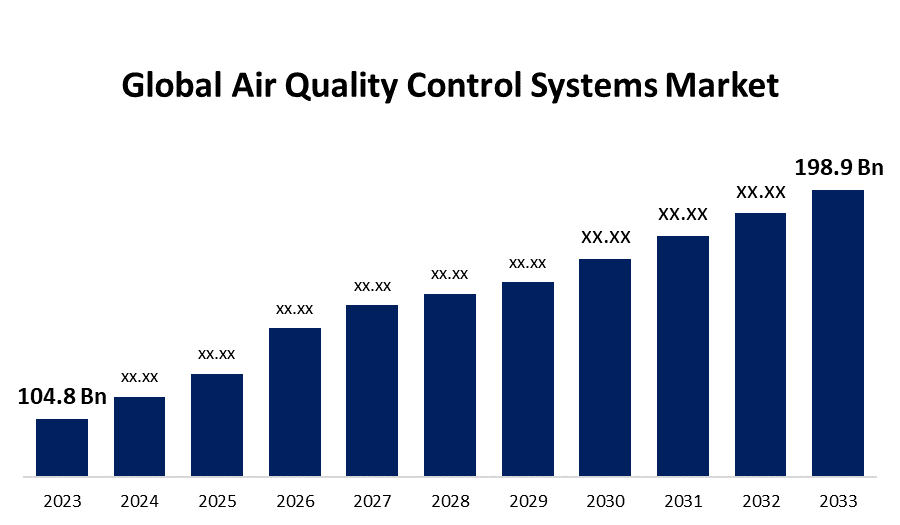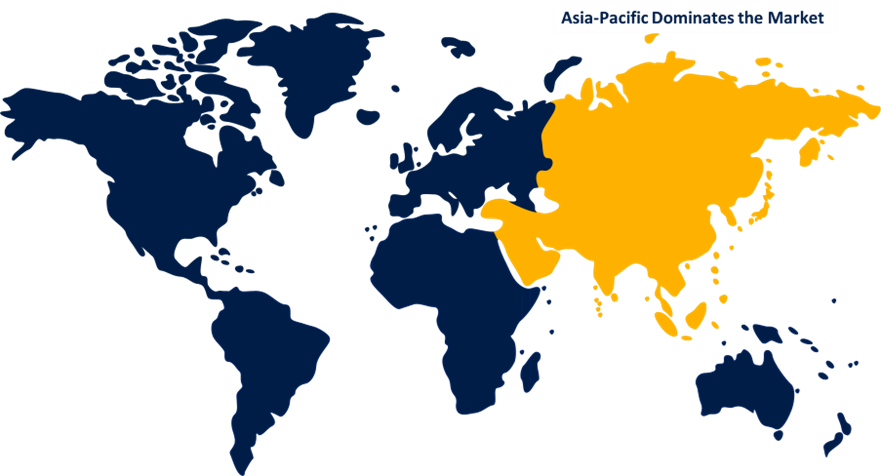Global Air Quality Control Systems Market Size, Share, and COVID-19 Impact Analysis, By Product (Indoor and Ambient), By Pollutant (Gas, VOC, Dust, and Others), By Application (Chemicals, Iron and Steel, Power Generation, Cement, and Others), and By Region (North America, Europe, Asia-Pacific, Latin America, Middle East, and Africa), Analysis and Forecast 2023 - 2033
Industry: Machinery & EquipmentGlobal Air Quality Control Systems Market Insights Forecasts to 2033
- The Global Air Quality Control Systems Market Size was Valued at USD 104.8 Billion in 2023
- The Worldwide Air Quality Control Systems Market Size is Growing at a CAGR of 6.62% from 2023 to 2033
- The Air Quality Control Systems Market Size is Expected to Reach USD 198.9 Billion by 2033
- Europe is Expected to Grow the fastest during the forecast period.

Get more details on this report -
The Global Air Quality Control Systems Market Size is Anticipated to Exceed USD 198.9 Billion by 2033, Growing at a CAGR of 6.62% from 2023 to 2033.
Market Overview
The air quality monitoring system serves as a measurement and analysis instrument for the state of the air in a particular location. Data collection and analysis on several air pollutants, including particulate matter (PM), ozone (O3), nitrogen dioxide (NO2), sulfur dioxide (SO2), and carbon monoxide (CO), usually involve a network of sensors, devices, and data processing tools. The goal is to minimize potential responsibility when their employees travel, many firms and companies are increasingly using air quality control systems. In addition to medical benefits like illness, accidental death and dismemberment are primarily covered by air quality control systems. It is even possible to expand these regulations to cover staff who work on-site. The production of power, cement, oil and gas processing, chemicals, and other industries all contribute to the production of these dangerous pollutants. By detecting the amounts of various gases in the environment, the air quality management systems keep an eye on the quality of the ambient air. Industrial pollution is releasing airborne particles into the atmosphere. Growing recognition of the significance of both indoor and outdoor air quality, along with strict environmental regulations that are anticipated to drive demand for air quality control systems, are expected to provide a favourable landscape for the market players during the projection period. The primary nitrogen oxide, mercury, fabric, electrostatic precipitators, and flue gas control systems for air quality are now on the market.
Report Coverage
This research report categorizes the market for the global air quality control systems market based on various segments and regions forecasts revenue growth and analyzes trends in each submarket. The report analyses the key growth drivers, opportunities, and challenges influencing the global air quality control systems market. Recent market developments and competitive strategies such as expansion, product launch, and development, partnership, merger, and acquisition have been included to draw the competitive landscape in the market. The report strategically identifies and profiles the key market players and analyses their core competencies in each sub-segment of the global air quality control systems market.
Global Air Quality Control Systems Market Report Coverage
| Report Coverage | Details |
|---|---|
| Base Year: | 2023 |
| Market Size in 2023: | USD 104.8 Billion |
| Forecast Period: | 2023-2033 |
| Forecast Period CAGR 2023-2033 : | 6.62% |
| 2033 Value Projection: | USD 198.9 Billion |
| Historical Data for: | 2019-2022 |
| No. of Pages: | 220 |
| Tables, Charts & Figures: | 110 |
| Segments covered: | By Product, By Pollutant, By Application, By Region |
| Companies covered:: | Thermax Limited, GEA Group Aktiengesellschaft, Air Spectrum Environmental Ltd, General Electric Company, Mitsubishi Heavy Industries, Ltd., Essar Enviro Air Systems, Babcock & Wilcox Enterprises, Inc, Hamon Corporation, EnviroAir, Inc, Beltran Technologies Inc., John Wood Group PLC, Southern Erectors, Inc., Tianjie Group Co. Ltd., Siemens AG., Thermax Global, and Others |
| Pitfalls & Challenges: | Covid 19 Impact Challanges, Future, Growth and Analysis |
Get more details on this report -
Driving Factors
The demand for air quality management systems is being significantly impacted by the rising emissions of greenhouse gases (GHGs). Global warming and climate change are caused by greenhouse gases (GHGs), which trap heat in the Earth's atmosphere. Examples of GHGs include carbon dioxide (CO2), methane (CH4), and nitrous oxide (N2O). The government's attempts to eliminate environmental pollution and the growing public concern about it are driving the market for air quality management systems. In recent years, several nations have transitioned from an agriculturally based to an industrially oriented urban economy. This change has an impact on a range of human activities since these industries pollute the environment and release a lot of hazardous gasses and particulates into the air. The air quality control systems market is being driven by the government's efforts to reduce environmental pollution and the increasing public concerns about it.
Restraining Factors
The demand for air quality management systems is being greatly impacted by the worldwide toward renewable energy. Conventional air quality management systems are becoming less necessary as fossil fuel-based energy sources like solar, wind and hydroelectric power replace fossil fuel-based energy in industry and power plants.
Market Segmentation
The global air quality control systems market share is classified into product, pollutant, and application.
- The ambient segment dominates the market with the largest market share through the forecast period.
Based on the product, the global air quality control systems market is categorized into indoor and ambient. Among these, the ambient segment dominates the market with the largest market share through the forecast period. The market covers a variety of applications, including air terminals, tunnels, subterranean parking, public transportation, automobiles, and air pollution management.
- The gas segment is anticipated to grow at the fastest CAGR growth through the forecast period.
Based on the pollutants, the global air quality control systems market is categorized into gas, VOC, dust, and others. Among these, the gas segment is anticipated to grow at the fastest CAGR growth through the forecast period. Highly dangerous gases released by industry and traffic, including carbon monoxide, sulfur dioxide, nitrogen oxides, and volatile organic compounds (VOCs), are monitored and managed via gas pollution control systems. The market for gas pollution control systems is expanding as a result of government limits on industrial emissions and a growing focus on lowering air pollution.
- The chemicals segment accounted for the largest revenue share through the forecast period.
Based on the application, the global air quality control systems market is categorized into chemicals, iron and steel, power generation, cement, and others. Among these, the chemicals segment accounted for the largest revenue share through the forecast period. It is anticipated that the chemical industry will offer significant prospects for participants, namely for producers of consumer, speciality, basic, and specialized chemicals.
Regional Segment Analysis of the Global Air Quality Control Systems Market
- North America (U.S., Canada, Mexico)
- Europe (Germany, France, U.K., Italy, Spain, Rest of Europe)
- Asia-Pacific (China, Japan, India, Rest of APAC)
- South America (Brazil and the Rest of South America)
- The Middle East and Africa (UAE, South Africa, Rest of MEA)
Asia Pacific is anticipated to hold the largest share of the global air quality control systems market over the predicted timeframe.

Get more details on this report -
Asia Pacific is anticipated to hold the largest share of the global air quality control systems market over the predicted timeframe. The governments of nations like China and India, which are already at the top of the list of the most polluted, have been compelled to enact legislation and regulations governing emission standards, opening the door for the adoption of AQCS in industry. Air quality has declined as a result of growing coal usage, illicit mining activities, and inefficient industrial processes. In addition, the primary causes of the high levels of greenhouse gas emissions are the rising per-capita energy use and demand. The Central Pollution Control Board (CPCB) has imposed air pollution control regulations and guidelines, which require the installation of air quality control systems in all sectors, to curb rising emission levels.
Europe is expected to grow at the fastest CAGR growth of the global air quality control systems market during the forecast period. The European market encompasses all of the countries in Eastern and Central Europe as well as the United Kingdom, Spain, Germany, Italy, and Russia. Government backing, a sizable potential market, and an emphasis on pollution reduction goals are driving the European industry. This is because different governments are attempting to manage the continuously declining quality of the air. To promote this developing industry, Europe has launched several support programs. Political stability and safe regulatory frameworks characterize the region.
Competitive Analysis:
The report offers the appropriate analysis of the key organizations/companies involved within the global air quality control systems market along with a comparative evaluation primarily based on their product offering, business overviews, geographic presence, enterprise strategies, segment market share, and SWOT analysis. The report also provides an elaborative analysis focusing on the current news and developments of the companies, which includes product development, innovations, joint ventures, partnerships, mergers & acquisitions, strategic alliances, and others. This allows for the evaluation of the overall competition within the market.
List of Key Companies
- Thermax Limited
- GEA Group Aktiengesellschaft
- Air Spectrum Environmental Ltd
- General Electric Company
- Mitsubishi Heavy Industries, Ltd.
- Essar Enviro Air Systems
- Babcock & Wilcox Enterprises, Inc
- Hamon Corporation
- EnviroAir, Inc
- Beltran Technologies Inc.
- John Wood Group PLC
- Southern Erectors, Inc.
- Tianjie Group Co. Ltd.
- Siemens AG.
- Thermax Global
- Others
Key Target Audience
- Market Players
- Investors
- End-users
- Government Authorities
- Consulting And Research Firm
- Venture capitalists
- Value-Added Resellers (VARs)
Recent Developments
- In May 2024, Mitsubishi Heavy Industries (MHI) partnered with Chiyoda Corporation to expand CO2 capture technology in Japan. MHI will license its co-developed capture process to Chiyoda, who can then offer engineering services for carbon capture projects. This collaboration leverages each company's strengths to meet decarbonization goals.
- In January 2023, Donaldson Company, Inc. launched Managed Filtration Services, combining their unique monitoring tech, industry expertise, and service network to offer condition-based maintenance and repair for industrial filtration equipment, optimizing performance and uptime.
Market Segment
This study forecasts revenue at global, regional, and country levels from 2020 to 2033. Spherical Insights has segmented the global air quality control systems market based on the below-mentioned segments:
Global Air Quality Control Systems Market, By Product
- Indoor
- Ambient
Global Air Quality Control Systems Market, By Pollutant
- Gas
- VOC
- Dust
- Others
Global Air Quality Control Systems Market, By Application
- Chemicals
- Iron and Steel
- Power Generation
- Cement
- Others
Global Air Quality Control Systems Market, By Region
- North America
- US
- Canada
- Mexico
- Europe
- Germany
- UK
- France
- Italy
- Spain
- Russia
- Rest of Europe
- Asia Pacific
- China
- Japan
- India
- South Korea
- Australia
- Rest of Asia Pacific
- South America
- Brazil
- Argentina
- Rest of South America
- Middle East & Africa
- UAE
- Saudi Arabia
- Qatar
- South Africa
- Rest of the Middle East & Africa
Need help to buy this report?